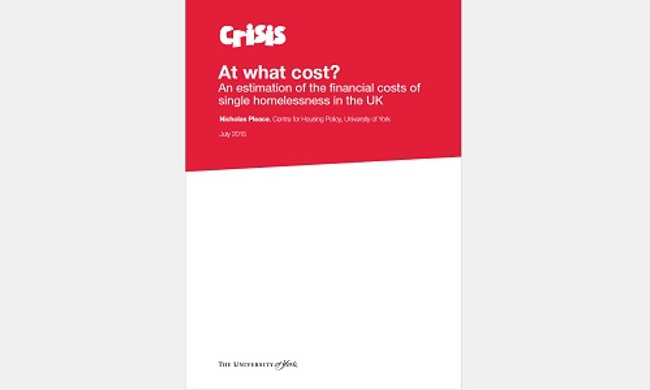At what cost? (2015)
20.03.2015
Explores the costs of homelessness to the public purse when it is not prevented early.
Key findings
Homelessness has a human cost. The unique distress of lacking a settled home can cause or intensify social isolation, create barriers to education, training and paid work and undermine mental and physical health. When single homelessness becomes prolonged, or is repeatedly experienced, there are often very marked deteriorations in health and well-being.
- This report, using qualitative and service cost data drawn from recent research, presents estimates that provide an overview of the additional financial costs of single homelessness can cause for the public sector.
- The additional financial costs of homelessness vary by the location, type and nature of support provided by homelessness services.
- There is international concern, both in Europe and North America, that sustained and repeated homelessness may have significant impacts on public expenditure. Costs for health care systems, including mental health services and emergency services at hospitals may be particularly high, as may costs for criminal justice systems.
- Four illustrative vignettes, based on estimations of additional costs, are presented in the report. These are a young woman experiencing homelessness, a man in his 30s who becomes a rough sleeper, a man with a learning difficulty who loses his existing home and a woman in her 20s escaping domestic violence. The additional financial costs of their homelessness are compared using two scenarios, one in which homelessness is prevented or quickly resolved and another in which homelessness persists for 12 months.
- The additional costs of homelessness can quickly become significant. Thirty people sleeping rough for 12 months, with an equivalent pattern of service use to vignette 2, would cost over £600,000 a year in additional public expenditure, rising to £1.2 million if the situation persisted for two years. Even in the lowest cost scenario, shown in vignette four, 30 people with equivalent patterns of service use would cost the public sector an additional £140,000, rising to £280,000 if their homelessness persisted for three years. The longer someone is homeless, or the more often they experience homelessness, the more they will cost the taxpayer.
- Preventing and quickly resolving single homelessness is, almost certainly, typically much less expensive for the public sector than allowing homelessness to be experienced for sustained periods or on a repeated basis.
Reference
Pleace, N. (2015) At what cost? An estimation of the financial costs of single homelessness in the UK. London: Crisis.

